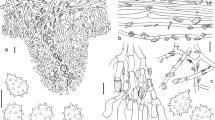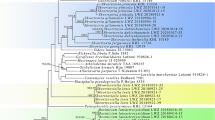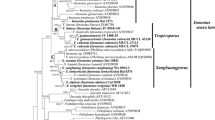Abstract
Collections from field expeditions to the Atlantic Forest and to Amazonia in Brazil and revision of herbarium material revealed the presence of Trechispora specimens that could not be assigned to any described species. Phylogenetic analysis based on nuc rDNA ITS1-5.8S-ITS2 (ITS) and nuc 28S rDNA (28S) regions confirmed that these specimens belong to two new species, here described as Trechispora mollis and Trechispora torrendii. Trechispora mollis has a densely hydnoid hymenophore and is most similar to T. nivea, but differs from it by the presence of inflated cells in the subiculum. Trechispora torrendii has a minutely grandinioid hymenophore similar to T. farinacea, but these two species are genetically well separated. The new combinations T. brasiliensis and T. mellina are proposed, and new records from Brazilian regions and biomes are reported. Descriptions, illustrations, a key to Brazilian species of Trechispora, the first sequence of T. rigida, and a phylogeny for the genus are presented.





Similar content being viewed by others
References
Albee-Scott S, Kropp BR (2010) A phylogenetic study of Trechispora thelephora. Mycotaxon 114:395–399. https://doi.org/10.5248/114.395
Bernicchia A, Gorjón SP (2010) Corticiaceae s.l. Fungi Europaei n12. Candusso.
Binder M, Hibbett DS, Larsson KH, Larsson E, Langer E, Langer G (2005) The phylogenetic distribution of resupinate forms across the major clades of mushroom-forming fungi (Homobasidiomycetes). Syst Biodivers 3:113–157. https://doi.org/10.1017/S1477200005001623
Birkebak JM, Mayor JR, Ryberg KM, Matheny PB (2013) A systematic, morphological and ecological overview of the Clavariaceae (Agaricales). Mycologia 105(4):896–911. https://doi.org/10.3852/12-070
Chikowski RS, Lira CRS, Larsson KH, Gibertoni TB (2020) A checklist of corticioid fungi (Agaricomycetes, Basidiomycota) from Brazil. Mycotaxon 135(2):467–467
Cifuentes J, Patiño-Conde V, Villegas M, García-Sandoval R, Valenzuela R (2005) First record of Hydnodon thelephorus from Belize, Dominican Republic, Mexico with new data on its morphology and distribution. Mycotaxon 91:27–34
Coker WC, Beers AH (1951) The stipitate Hydnum of eastern United States. Cramer, Chapel Hill
Desjardin DE, Perry BA (2015) A new species of Scytinopogon from the island of Príncipe, Republic of São Tomé and Príncipe, West Africa. Mycosphere 6:433–440. https://doi.org/10.5943/mycosphere/6/4/5
Gardes M, Bruns TD (1993) ITS primers with enhanced specificity for basidiomycetes - application to the identification of mycorrhizas and rusts. Mol Ecol 2:113–118. https://doi.org/10.1111/j.1365-294X.1993.tb00005.x
Góes-Neto A, Loguercio-Leite C, Guerrero RT (2005) DNA extraction from frozen field collected and dehydrated herbarium fungal basidiomata: performance of SDS and CTAB-based methods. Biotemas 18:19–32. https://doi.org/10.5007/%25x
Hibbett DS, Binder M, Bischoff JF, Blackwell M, Cannon PF, Eriksson OE, Huhndorf S, James T, Kirk PM, Lücking R, Lumbsch T, Lutzoni F, Matheny PB, Mclaughlin DJ, Powell MJ, Redhead S, Schoch CL, Spatafora JW, Stalpers JA, Vilgalys R, Aime MC, Aptroot A, Bauer R, Begerow D, Benny GL, Castlebury LA, Crous PW, Dai Y-C, Gams W, Geiser DM, Griffith GW, Gueidan C, Hawksworth DL, Hestmark G, Hosaka K, Humber RA, Hyde K, Ironside JE, Kõljalg U, Kurtzman CP, Larsson K-H, Lichtwardt R, Longcore J, Miadlikowska J, Miller A, Moncalvo J-M, Mozley-Standridge S, Oberwinkler F, Parmasto E, Reeb V, Rogers JD, Roux C, Ryvarden L, Sampaio JP, Schüßler A, Sugiyama J, Thorn RG, Tibell L, Untereiner WA, Walker C, Wang Z, Weir A, Weiß M, White MM, Winka K, Yao Y-J, Zhang N (2007) A higher-level phylogenetic classification of the Fungi. Mycol Res 111:509–547. https://doi.org/10.1016/j.mycres.2007.03.004
Hjortstam K, Bononi VLR (1987) A contribution to the knowledge of Corticiaceae s.l. (Aphyllophorales) in Brazil. Mycotaxon 28:1–15
Hjortstam K, Ryvarden L (1980) Studies in Tropical Corticiaceae (Basidiomycetes) II. Mycotaxon 12:168–184
Hjortstam K, Ryvarden L (2007a) Checklist of corticioid fungi (Basidiomycotina) from the tropics, subtropics and the southern hemisphere. Syn Fung 22:27–146
Hjortstam K, Ryvarden L (2007b) Studies in corticioid fungi from Venezuela III (Basidiomycotina, Aphyllophorales). Syn Fung 23:56–107
Hjortstam K, Larsson KH, Ryvarden L (1987) The Corticiaceae of North Europe vol. 1. Fungiflora, Oslo, p 63
Hopple JSJR, Vilgalys R (1999) Phylogenetic relationships in the mushroom genus Coprinus and dark spored allies based on sequence data from the nuclear gene coding for the large ribosomal subunit RNA: divergent domains, outgroups, and monophyly. Mol Phyl Evol 13:1–19
James TY, Moncalvo JM, Li S, Vilgalys R (2001) Polymorphism at the ribosomal DNA spacers and its relation to breeding structure of the widespread mushroom Schizophyllum commune. Genetics 157:149–161
Jørgensen PM (2019) The troublesome genus Thamnolia (lichenized Ascomycota). Lichenologist 51:221–226. https://doi.org/10.1017/S0024282919000203
Jülich W (1981) Higher taxa of Basidiomycetes. Bibl Mycol 85:1–485
Karsten PA (1890) Fragmenta mycologica XXIX. Hedwigia 29:147–149
Katoh K, Rozewicki J, Yamada KD (2019) MAFFT online service: multiple sequence alignment, interactive sequence choice and visualization. Brief Bioinform 20:116–1166. https://doi.org/10.1093/bib/bbx108
Kirk PM, Cannon PF, Minter DW, Stalpers JA (2008) Dictionary of the fungi. CABI, Wallingford, p 784
Larsson K-H (1992) The genus Trechispora (Corticiaceae, Basidiomycetes). Dissertation, University of Gothenburg
Larsson K-H (1994) Poroid species in Trechispora and the use of calcium oxalate crystals. Mycol Res 98:1153–1172
Larsson K-H (1995) Taxonomy of Trechispora farinacea and proposed synonyms I. Species with a grandinioid or hydnoid hymenophore. Symb Bot Upsal 30(3):101–118
Larsson K-H (1996) New species and combinations in Trechispora. Nord J Bot 16:83–98
Larsson K-H (2001) The position of Poria mucida inferred from nuclear ribosomal DNA sequences. Harv Pap Bot 6:131–138
Larsson K-H (2007) Re-thinking the classification of corticioid fungi. Mycol Res 111:1040–1063. https://doi.org/10.1016/j.mycres.2007.08.001
Larsson K-H, Larsson E, Kõljalg U (2004) High phylogenetic diversity among corticioid homobasidiomycetes. Mycol Res 108:983–1002. https://doi.org/10.1017/S0953756204000851
Larsson K-H, Læssøe T, Yorou NS, Ryvarden L (2011) The phylogenetic position of Hydnodon and Scytinopogon. Mycological Society of American meeting, Fairbanks, Alaska, 2–5 Aug 2011 (abstract)
Liberta AE (1966) On Trechispora. Taxon 15:317–319
Liberta AE (1973) The genus Trechispora (Basidiomycetes, Corticiaceae). Can J Bot 51:1871–1892
Lücking R, Aime MC, Robbertse B, Miller AN, Ariyawansa HA, Aoki T, Cardinali G, Crous PW, Druzhinina IS, Geiser DM, Hawksworth DL, Hyde KD, Irinyi L, Jeewon R, Johnston PR, Kirk PM, Malosso E, May TW, Meyer W, Öpik M, Robert V, Stadler M, Thines M, Vu D, Yurkov AM, Zhang N (2020) Schoch CL (2020) Unambiguous identification of fungi: where do we stand and how accurate and precise is fungal DNA barcoding? IMA Fungus 11:14. https://doi.org/10.1186/s43008-020-00033-z
Miettinen O, Larsson KH (2006) Trechispora elongata species nova from North Europe. Mycotaxon 96:193–198
Milne I, Lindner D, Bayer M, Husmeier D, McGuire G, Marshall DF, Wright F (2009) TOPALi v2: a rich graphical interface for evolutionary analyses of multiple alignments on HPC clusters and multi-core desktops. Bioinformatics 25:126–127
Motato-Vásquez V, Gugliotta AM (2013) Polypores from an Atlantic rainforest area in southeast Brazil: Resupinate Species. Braz J Bot 36:211–221
Nguyen LT, Schmidt HA, Von Haeseler A, Minh BQ (2015) IQ-TREE: A fast and effective stochastic algorithm for estimating maximum likelihood phylogenies. Mol Biol Evol 32:268–274. https://doi.org/10.1093/molbev/msu300
Ordynets A, Larsson KH, Langer E (2015) Two new Trechispora species from La Réunion Island. Mycol Prog 14:1–11. https://doi.org/10.1007/s11557-015-1133-0
Phookamsak R, Hyde KD, Jeewon R, Bhat DJ, Jones EBG, Maharachchikumbura SSN, Raspé O, Karunarathna SC, Wanasinghe DN, Hongsanan S, Doilom M, Tennakoon DS, Machado AR, Firmino, AL, Ghosh A, Karunarathna A, Mesic A, Dutta AK, Thongbai B, Devadatha B, Norphanphoun C, Senwanna C, Wei D, Pem D, Ackah FK, Wang GN, Jiang HB, Madrid H, Lee, HB, Goonasekara ID, Manawasinghe IS, Kusan I, Cano J, Gené J, Li J, Das K, Acharya K, Raj KNA, Latha KPD, Chethana KWT, He MQ, Duenãs M, Jadan M, Martín MP, Samarakoon MC, Dayarathne MC, Raza M, Park MS, Telleria MT, Chaiwan N, Matocec N, Silva NI, Pereira OL, Singh PN, Manimohan P, Uniyal P, Shang QJ, Bhatt RP, Perera RH, Alvarenga RLM, Sandra Nogal-Prata S, Singh SK, Vadthanarat S, Oh SY, Huang SK, Rana S, Konta S, Paloi S, Jayasiri SC, Jeon SJ, Mehmood T, Gibertoni TB, Nguyen TTT, Singh U, Thiyagaraja V, Sarma VV, Dong W, Yu XD, Lu Y, Lim YW, Chen Y, Tkalcec Z, Zhang ZF, Luo ZL, Daranagama DA, Thambugala KM, Saowaluck Tibpromma S, Camporesi E, Bulgakov TS, Dissanayake AJ, Senanayake IC, Dai DQ, Tang LZ, Khan S, Zhang H, Promputtha I, Cai L, Chomnunti P, Zhao RL, Lumyong S, Boonmee S, Wen TC, Mortimer PE, Xu J (2019) Fungal diversity notes 929–1035: taxonomic and phylogenetic contributions on genera and species of fungi. https://doi.org/10.1007/s13225-019-00421-w
Rogers SO, Bendich AJ (1985) Extraction of DNA from milligram amounts of fresh, herbarium and mummified plant tissues. Plant Mol Biol 5:69–76
Ryvarden L (2002) A note on the genus Hydnodon Banker. Syn Fung 15:31–33
Silveira RMB (2016) Trechisporales in Lista de Espécies da Flora do Brasil. Jardim Botânico do Rio de Janeiro. Available online at http://floradobrasil.jbrj.gov.br/jabot/floradobrasil/FB95394.
Sjökvist E, Larsson E, Eberhard U, Ryvarden L, Larsson K-H (2012) Stipitate stereoid basidiocarps have evolved multiple times. Mycologia 104:1046–1055
Smith BJ, Sivasithamparam K (2000) Internal transcribed spacer ribosomal DNA sequence of five species of Ganoderma from Australia. Mycol Res 104:943–951
Staden R (1996) The staden sequence analysis package. Mol Biotechnol 5:233–241
Talavera G, Castresana J, Kjer K, Page R, Sullivan J (2007) Improvement of Phylogenies after Removing Divergent and Ambiguously Aligned Blocks from Protein Sequence Alignments. Syst Biol 56(4):564–577
Tellería MT, Melo I, Dueñas M, Larsson K-H, Martín MPP (2013) Molecular analyses confirm Brevicellicium in Trechisporales. IMA Fungus 4:21–28
Thiers B. (n.d.continuously updated). Index Herbariorum: a global directory of public herbaria and associated staff. New York Botanical Garden’s Virtual Herbarium. [cited 2020 Apr]. Available from: http://sweetgum.nybg.org/ih/
Trichiès G, Schultheis B (2002) Trechispora antipus sp. nov., une seconde espèce bisporique du genre Trechispora (Basidiomycota,Stereales). Mycotaxon 82:453–458
Vu D, Groenewald M, De Vries M, Gehrmann T, Stielow B, Eberhardt U, Al-Hatmi A, Groenewald JZ, Cardinali G, Houbraken J, Boekhout T, Crous PW, Robert V, Verkley GJM (2019) Large-scale generation and analysis of filamentous fungal DNA barcodes boosts coverage for kingdom fungi and reveals thresholds for fungal species and higher taxon delimitation. Stud Mycol 92:135–154. https://doi.org/10.1016/j.simyco.2018.05.001
Watling R (1969) Colour identification chart. Her Majesty’s Stationary Office, Edinburgh
Westphalen MC, Silveira RMB (2012) Resupinate polypores from mixed ombrophilous forests in southern Brazil. Mycotaxon 122:111–122
White TJ, Bruns T, Lee S, Taylor J (1990) Amplification and direct sequencing of fungal ribosomal RNA genes for phylogenetics. In: Innis MA, Gelfand DH, Sninsky JJ, White TJ (eds) PCR protocols: a guide to methods and applications. Academic Press, New York, pp 315–322
Xu TM, Chen YH, Zhao CL (2019) Trechispora yunnanensis sp. nov. (Hydnodontaceae, Basidiomycota) from China. Phytotaxa 424:253–261
Yurchenko E, Wu SH (2014) Fibrodontia alba sp. nov. (Basidiomycota) from Taiwan. Mycoscience 55(5):336–343. https://doi.org/10.1016/j.myc.2013.12.004
Acknowledgments
We thank Usina Colônia for the support during the field trips of RSC in RPPN Frei Caneca; Herbário Pe. Camille Torrend (URM) for loaning the exsiccates; and the staff of Laboratório de Micologia Aplicada (Universidade do Minho) for helping TBG sequencing T. thelephora (URM93137 and URM93138). Further, we acknowledge the Coordenação de Aperfeiçoamento de Pessoal de Nível Superior (CAPES) for the master scholarship and Fundação de Amparo à Ciência e Tecnologia do Estado de Pernambuco (FACEPE) for the doctorate scholarship of RSC; the Conselho Nacional de Desenvolvimento Científico e Tecnológico (PROTAX 562106/2010-3, Universal 472792/2011-3, SISBIOTA 563342/2010-2), CAPES (Capes-SIU 008/13, PRINT 88887.311891/2018-00) and FACEPE (APQ 0788-2.03/12, ATP-0021-2.03/18) for financing this research, and Pós-Graduação em Biologia de Fungos (UFPE) for financial support.
Author information
Authors and Affiliations
Corresponding author
Additional information
Publisher’s note
Springer Nature remains neutral with regard to jurisdictional claims in published maps and institutional affiliations.
Section editor: Yu-Cheng Dai.
This article is part of the Topical collection on diversity and phylogeny of wood-decaying Basidiomycota.
Rights and permissions
About this article
Cite this article
dos Santos Chikowski, R., Larsson, KH. & Gibertoni, T.B. Taxonomic novelties in Trechispora (Trechisporales, Basidiomycota) from Brazil. Mycol Progress 19, 1403–1414 (2020). https://doi.org/10.1007/s11557-020-01635-y
Received:
Revised:
Accepted:
Published:
Issue Date:
DOI: https://doi.org/10.1007/s11557-020-01635-y




